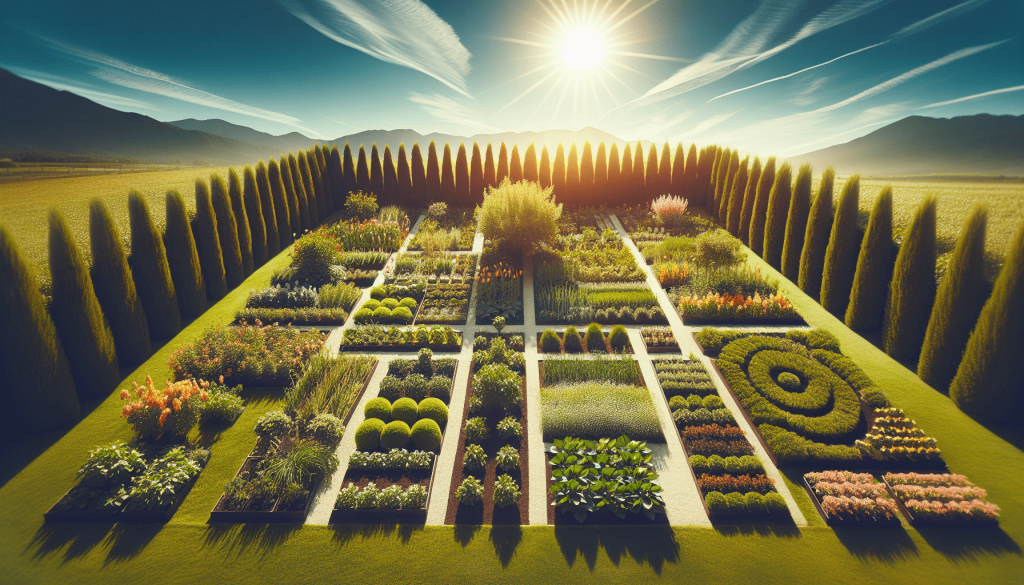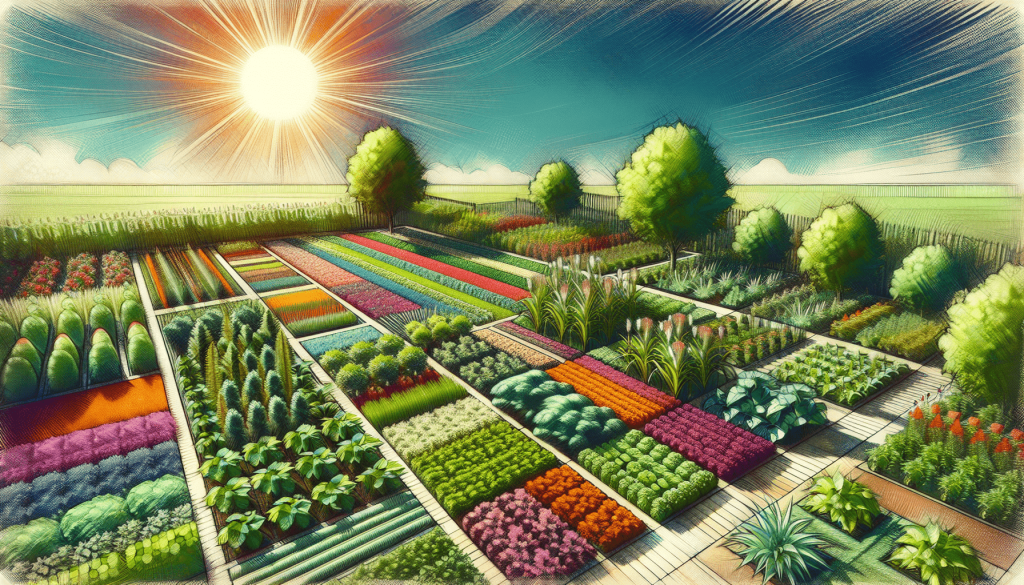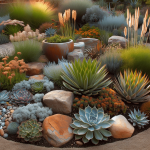This post may contain affiliate links. As an Amazon Associate, we may earn commissions from qualifying purchases.
Have you ever wondered how to best plan a garden that takes full advantage of the sun’s rays? Whether you’re new to gardening or have a green thumb, understanding how to maximize sun exposure can make a world of difference. Not only does it help your plants thrive, but it can also lead to a bountiful harvest and a garden that’s the envy of the neighborhood.
Understanding Sun Exposure
Before we get into the nitty-gritty of garden planning, let’s first talk about sun exposure. The term itself might sound simple, but there’s a lot to consider when planning your garden.
Why Sun Exposure Matters
Plants need sunlight for photosynthesis, the process by which they convert light into energy. The amount and duration of sunlight directly impact a plant’s growth, health, and yield. Lack of adequate sun can lead to leggy plants and scanty produce, while too much sun can scorch leaves and stunt growth.
Types of Sun Exposure
Knowing the types of sun exposure can help you tailor your garden to the needs of different plants. Here’s a quick breakdown:
| Type of Sun Exposure | Definition |
|---|---|
| Full Sun | At least 6-8 hours of direct sunlight per day |
| Partial Sun | About 4-6 hours of direct sunlight per day |
| Partial Shade | 2-4 hours of direct sunlight per day |
| Full Shade | Less than 2 hours of direct sunlight per day |
By understanding these types, you can better choose plants and plan their placement in your garden for optimal health and productivity.
Site Selection: The First Step
Choosing the right location for your garden is pivotal. You’ll need to observe your outdoor space and note where the sunniest and shadiest spots are throughout the day.
Conduct a Sunlight Audit
A sunlight audit may sound like a fancy term, but it’s really about spending a few days observing how sunlight moves across your yard. Take notes at various times of the day—early morning, late morning, noon, mid-afternoon, and early evening. This will give you a clearer picture of potential garden spots.
Factors to Consider
Several factors can influence sunlight availability:
- Seasonal Changes: The angle of the sun changes with the seasons, affecting how light hits your garden.
- Obstructions: Trees, fences, buildings, and other structures can block sunlight.
- Climate: Overcast climates may require you to plan for more sunlight than sunny, arid regions.

Layout and Design
Once you’ve chosen the best spot, it’s time to think about the layout and design. This is where you can get creative, but keep in mind the fundamental goal: maximizing sun exposure.
Raised Beds vs. In-Ground Gardens
Deciding between raised beds and in-ground gardens can impact how sunlight reaches your plants.
Raised Beds
Raised beds can be advantageous for several reasons. They warm up quicker in the spring and drain better, which can be ideal for plants that require plenty of sunlight and well-drained soil.
In-Ground Gardens
In-ground gardens are often less labor-intensive initially but can have issues with poor drainage and compacted soil. However, they are perfect for plants that don’t require high amounts of sunlight and need a more consistent moisture level.
Row Orientation
Believe it or not, the direction you plant your rows can make a difference. A north-south orientation will generally provide the most even sun exposure, especially during the middle of the growing season when the sun is at its highest.
| Row Orientation | Ideal Conditions |
|---|---|
| North-South | Consistent sun exposure throughout the day |
| East-West | More sun on southern rows, less on northern rows |
Plant Height and Spacing
Another critical factor is the height and spacing of your plants. Taller plants can cast shadows on shorter plants, so plan your layout with this in mind.
- Tall Plants: Plant taller crops like corn and sunflowers on the north side of the garden to prevent them from shading shorter plants.
- Short Plants: Place shorter plants that require full sun in front or south of taller plants.
- Spacing: Ensure adequate spacing between plants. Crowding can lead to shading and competition for sunlight.
Choosing the Right Plants
Selecting plants suited to the type of sunlight in your garden is crucial. Not all plants have the same light requirements, so it is essential to know what works best.
Sun-Loving Plants
These plants thrive in full sun conditions (6-8 hours of sunlight):
- Tomatoes
- Peppers
- Squash
- Roses
- Lavenders
Shade-Tolerant Plants
If any parts of your garden fall into partial shade or full shade categories, consider these options:
- Lettuce
- Spinach
- Ferns
- Hostas
- Impatiens
Mixed Light Requirements
For areas that experience both sun and partial shade, versatile plants include:
- Cucumbers
- Beans
- Carrots
- Broccoli
- Daylilies

Gardening Tools and Gadgets
Several tools and gadgets can help you better understand and optimize sun exposure. Here are a few worth considering:
Sunlight Meters
These tools measure the amount of light in a specific area. They can be especially helpful for shaded or partially shaded gardens to determine how much light different spots are receiving.
Reflective Mulch
Using reflective mulch can help increase light exposure, especially for plants that might not be receiving full sun. It reflects sunlight back up onto the plants, giving them an extra boost.
Shade Cloths
Sometimes, especially in the peak of summer, you may need to protect your plants from too much sun. Shade cloths can help by providing a bit of relief while still allowing some light to filter through.
Seasonal Adjustments
Sun exposure isn’t static—what works in spring may not be ideal in summer or fall. Adjusting your garden throughout the growing season can help maintain optimal conditions.
Spring
Spring is the time when your garden begins to wake up. With the sun’s angle still relatively low, it’s critical to maximize every bit of the available sunlight. Start planting sun-loving plants earlier in raised beds to extend the growing season.
Summer
Summer brings the highest sun exposure. Here, you might need to provide some shade for certain plants to prevent scorching. Regular watering becomes even more crucial to keep plants from drying out.
Fall
As the days shorten and the sun dips lower, some parts of your garden might not receive as much sunlight. Consider using row covers or cold frames to extend the growing season for sun-loving plants.
Maintenance and Monitoring
Effective garden maintenance is ongoing. Regularly monitoring and adjusting can help you adapt to changing conditions and keep your garden thriving.
Pruning
Regularly pruning your plants can help improve sun exposure. Remove any dead or overgrown branches that might be shading other plants. This encourages healthy growth and allows sunlight to penetrate deeper into the foliage.
Mulching
Mulching does more than just retain moisture and prevent weeds. Light-colored mulch can also reflect additional light onto your plants, improving their overall exposure.
Regular Assessments
Conduct periodic assessments of your garden’s sunlight exposure. Seasonal changes, plant growth, and other factors might necessitate adjustments. Being proactive will ensure your plants continue to receive the optimal amount of sunlight.
Practical Tips for Success
While the theory is excellent, sometimes practical tips can make implementing these ideas more manageable.
Using Indoor Plants for Experimentation
Why not practice with indoor plants to get a feel for sunlight needs before you expand to an outdoor garden? Place different plants in various spots in your home and observe which locations yield the healthiest growth.
Plant Trials
Try planting the same type of plant in different areas of your garden to see where it grows best. You can then tailor your planting strategy based on these observations.
Gardening Community
Joining a local gardening club or online forum can provide invaluable insights. Fellow gardeners can share their experiences and tips specific to your area’s climate and soil conditions.
Final Thoughts
Planning a garden to maximize sun exposure takes time, observation, and a bit of effort, but the rewards are well worth it. You’ll find that a well-planned garden not only looks beautiful but also produces healthy, vibrant plants.
Every gardener’s journey is unique, and what works for one might not work for another. The key is to stay observant, be flexible, and enjoy the process. Gardens have a way of teaching us patience, persistence, and the joy of nurturing life.
So, grab your notebook, sun hat, and perhaps a cool drink, and step into your garden with renewed purpose. The sun is waiting to work its magic on your plants, and with a bit of planning, your garden will flourish like never before.








